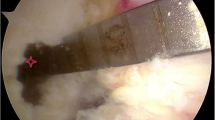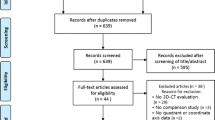Abstract
Introduction
A flexible reamer system (FRS) for transportal anterior cruciate ligament reconstruction (ACLR) has been developed to overcome the technical challenges of a rigid reamer system. The purpose of this study was to investigate the safety and effectiveness of the two-portal technique using an FRS by evaluating femoral tunnel geometry.
Methods
This study included 30 patients (mean age 30 ± 12.1) who underwent transportal single-bundle ACLR. Operations were performed with the two-portal technique using an FRS. Three-dimensional computed tomography was performed for all patients 2 days after the operation. The femoral tunnel position, femoral graft bending angle, femoral tunnel length, and posterior wall breakage were evaluated. These radiologic outcomes were compared to previous literature-reported outcomes.
Results
The mean distances (measured as a percentage) from the posterior wall and the intercondylar notch roof to the femoral tunnel center were 29.6 ± 5.5% and 20.1 ± 6.7%, respectively. The femoral graft bending angle (108.4° ± 6.9°) was similar to that associated with the traditional transportal technique using a rigid reamer system, but it was less acute than that associated with the three-portal technique using an FRS. The femoral tunnel length (32.8 ± 4.5 mm) was also similar to the results of the traditional transportal technique using a rigid reamer system, but it was shorter than that of three-portal technique using an FRS. The prevalence of posterior wall breakage was as low as the reported outcomes of the outside-in technique (2 cases, 6.6%).
Conclusions
The two-portal technique for transportal ACLR using an FRS can achieve comparable femoral graft bending angle and femoral tunnel length compared with the conventional three-portal technique using the rigid reamer system and had a low risk of posterior wall breakage. Therefore, the two-portal technique using the FRS can be considered a safe and effective method for transportal ACLR.
Level of evidence
Retrospective case series; level of evidence, 4





Similar content being viewed by others
References
Ahn JH, Lee YS, Jeong HJ, Park JH, Cho Y, Kim K-J, Ko TS (2017) Comparison of transtibial and retrograde outside-in techniques of anterior cruciate ligament reconstruction in terms of graft nature and clinical outcomes: a case control study using 3T MRI. Arch Orthop Trauma Surg 137(3):357–365
Parkinson B, Gogna R, Robb C, Thompson P, Spalding T (2017) Anatomic ACL reconstruction: the normal central tibial footprint position and a standardised technique for measuring tibial tunnel location on 3D CT. Knee Surg Sports Traumatol Arthrosc 25(5):1568–1575
Zhu M, Li S, Su Z, Zhou X, Peng P, Li J, Wang J, Lin L (2018) Tibial tunnel placement in anatomic anterior cruciate ligament reconstruction: a comparison study of outcomes between patient-specific drill template versus conventional arthroscopic techniques. Arch Orthop Trauma Surg 138(4):515–525
Rothrauff BB, Jorge A, de Sa D, Kay J, Fu FH, Musahl V (2019) Anatomic ACL reconstruction reduces risk of post-traumatic osteoarthritis: a systematic review with minimum 10-year follow-up. Knee Surg Sports Traumatol Arthrosc. https://doi.org/10.1007/s00167-019-05665-2
Tashiro Y, Irarrázaval S, Osaki K, Iwamoto Y, Fu FH (2017) Comparison of graft bending angle during knee motion after outside-in, trans-portal and trans-tibial anterior cruciate ligament reconstruction. Knee Surg Sports Traumatol Arthrosc 25(1):129–137
Kim JG, Chang MH, Lim HC, Bae JH, Lee SY, Ahn JH, Wang JH (2015) An in vivo 3D computed tomographic analysis of femoral tunnel geometry and aperture morphology between rigid and flexible systems in double-bundle anterior cruciate ligament reconstruction using the transportal technique. Arthroscopy 31(7):1318–1329
Park JS, Park JH, Wang JH, Oh CH, Hwang MH, Lee SH, Kim JG (2015) Comparison of femoral tunnel geometry, using in vivo 3-dimensional computed tomography, during transportal and outside-in single-bundle anterior cruciate ligament reconstruction techniques. Arthroscopy 31(1):83–91
Nakamura K, Nakamura T, Horie M, Katagiri H, Otabe K, Nakagawa Y, Amemiya M, Sekiya I, Muneta T, Koga H (2019) Anatomic femoral tunnel placement is difficult by the transtibial technique: comparison of three different femoral tunnel drilling techniques in double-bundle anterior cruciate ligament reconstructions. Knee Surg Sports Traumatol Arthrosc. https://doi.org/10.1007/s00167-019-05740-8
Dhawan A, Gallo RA, Lynch SA (2016) Anatomic tunnel placement in anterior cruciate ligament reconstruction. J Am Acad Orthop Surg 24(7):443–454
Silver AG, Kaar SG, Grisell MK, Reagan JM, Farrow LD (2010) Comparison between rigid and flexible systems for drilling the femoral tunnel through an anteromedial portal in anterior cruciate ligament reconstruction. Arthroscopy 26(6):790–795
Steiner ME, Smart LR (2012) Flexible instruments outperform rigid instruments to place anatomic anterior cruciate ligament femoral tunnels without hyperflexion. Arthroscopy 28(6):835–843
Larson AI, Bullock DP, Pevny T (2012) Comparison of 4 femoral tunnel drilling techniques in anterior cruciate ligament reconstruction. Arthroscopy 28(7):972–979
Kosy JD, Walmsley K, Anaspure R, Schranz PJ, Mandalia VI (2019) Flexible reamers create comparable anterior cruciate ligament reconstruction femoral tunnels without the hyperflexion required with rigid reamers: 3D-CT analysis of tunnel morphology in a randomised clinical trial. Knee Surg Sports Traumatol Arthrosc. https://doi.org/10.1007/s00167-019-05709-7
Fitzgerald J, Saluan P, Richter DL, Huff N, Schenck RC (2015) Anterior cruciate ligament reconstruction using a flexible reamer system: technique and pitfalls. Orthop J Sports Med. https://doi.org/10.1177/2325967115592875
Kim JG, Wang JH, Lim HC, Ahn JH (2012) Femoral graft bending angle and femoral tunnel geometry of transportal and outside-in techniques in anterior cruciate ligament reconstruction: an in vivo 3-dimensional computed tomography analysis. Arthroscopy 28(11):1682–1694
Rasmussen JF, Lavery KP, Dhawan A (2013) Anatomic anterior cruciate ligament reconstruction with a flexible reamer system and 70 degrees arthroscope. Arthrosc Tech 2(4):e319–322
Sinha A, Monga P (2016) Is there a significant blind spot created by 70 degree scope as compared with 30 degree?: a comparative study. In: Orthopaedic proceedings, vol Supp_13. The British Editorial Society of Bone & Joint Surgery, p 5
Fitzgerald J, Saluan P, Richter DL, Huff N, Schenck RC (2015) Anterior cruciate ligament reconstruction using a flexible reamer system: technique and pitfalls. Orthop J Sports Med 3(7):2325967115592875
Bernard M, Hertel P, Hornung H, Cierpinski T (1997) Femoral insertion of the ACL. Radiographic quadrant method. Am J Knee Surg 10(1):14–21
Piefer JW, Pflugner TR, Hwang MD, Lubowitz JH (2012) Anterior cruciate ligament femoral footprint anatomy: systematic review of the 21st century literature. Arthroscopy 28(6):872–881
Greis PE, Burks RT, Bachus K, Luker MG (2001) The influence of tendon length and fit on the strength of a tendon-bone tunnel complex: a biomechanical and histologic study in the dog. Am J Sport Med 29(4):493–497
Zantop T, Ferretti M, Bell KM, Brucker PU, Gilbertson L, Fu FH (2008) Effect of tunnel-graft length on the biomechanics of anterior cruciate ligament-reconstructed knees: intra-articular study in a goat model. Am J Sport Med 36(11):2158–2166
Jeon YS, Choi SW, Park JH, Yoon JS, Shin JS, Kim MK (2017) Mid-term outcomes of anterior cruciate ligament reconstruction with far anteromedial portal technique. Knee Surg Relat Res 29(1):19–25
Kim K-I, Lee SH, Bae C, Bae SH (2017) Three-dimensional reconstruction computed tomography evaluation of the tunnel location and angle in anatomic single-bundle anterior cruciate ligament reconstruction: a comparison of the anteromedial portal and outside-in techniques. Knee Surg Relat Res 29(1):11–18
Erdem M, Gulabi D, Asil K, Erdem AC (2015) Farmedial versus anteromedial portal drilling of the femoral tunnel in ACL reconstruction: a computed tomography analysis. Arch Orthop Trauma Surg 135(4):539–547
Funding
There is no funding source.
Author information
Authors and Affiliations
Corresponding author
Ethics declarations
Conflict of interest
The authors declare that they have no conflict of interest.
Ethical approval
Institutional review board approval was obtained by the ethics committee of Kyung Hee University Hospital (IRB Number: KHUH 2018-12-027).
Additional information
Publisher's Note
Springer Nature remains neutral with regard to jurisdictional claims in published maps and institutional affiliations.
Rights and permissions
About this article
Cite this article
Yoon, K.H., Kim, J.H., Kwon, Y.B. et al. A two-portal technique using a flexible reamer system is a safe and effective method for transportal anterior cruciate ligament reconstruction. Arch Orthop Trauma Surg 140, 383–390 (2020). https://doi.org/10.1007/s00402-020-03343-4
Received:
Published:
Issue Date:
DOI: https://doi.org/10.1007/s00402-020-03343-4




